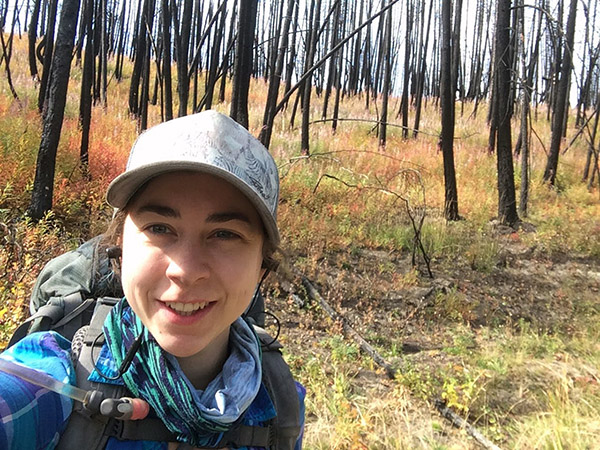UNIVERSITY OF MONTANA NEWS
MISSOULA—For a researcher who studies wildfire, University of Montana graduate student Kyra Clark-Wolf couldn’t have had better timing.
Clark-Wolf arrived in Missoula to start her graduate studies on the impacts of wildfires on forests at the W.A. Franke College of Forestry & Conservation on July 4, 2017. Eleven days later, a lightning strike sparked the Lolo Peak Fire just south of the city, burning nearly 54,000 acres and leaving lasting and indelible images among Missoulians of dense smoke and flames visible from town.
The impacts of that fire on the forest, as well as the Sunrise Fire burning at the same time west of Missoula, would go on to be central to Clark-Wolf’s doctoral work. Her findings are shared in two papers, the second recently published in Forest Ecology and Management, a leading journal in her field.
“I was curious once the smoke cleared up what was going on in the forest and what the fires left behind,” she said, “and how the effects of ongoing climate change could change forest recovery.”

With support from her adviser, Philip Higuera, professor and director of UM’s PaleoEcology and Fire Ecology Lab, and Kim Davis, a UM research scientist, Clark-Wolf applied for $25,000 in research funding from the federal Joint Fire Science Program and proposed to study how burned landscapes find life again.
She chose the Lolo Peak and Sunrise fires for the very practical reason that both were close by, and for the next three years her research would require endless road trips, arduous hikes and hours spent counting tiny tree seedlings and measuring their growth.
Her laboratories were 69 field plots staked out at mountain locations far from roads and recreational sites. Her subjects were the thousands of tiny tree seedlings she marked and followed over the years. She also tracked the “micro-site” conditions where those seedlings grew.
“We wanted to see how warm and dry it gets right at the ground surface, and what was happening with the soils,” she said of her research, which included help from a number of undergraduate students. “Soil conditions are important because that’s where plants get moisture and nutrients like nitrogen.”
Her studies found thousands of seedlings growing after the fires, especially at sites with cooler, damper conditions – often found in the shade of the dead trees and upper canopy, as well as on the north side of mountains with higher elevations and more undergrowth. She found fewer seedlings at sites with less shade and drier, hotter conditions.
In the case of the Lolo Peak and Sunrise fires, moderate temperatures and ample rain in the years since the fires helped seedlings get started and survive in the burned areas, but as climate change continues, Clark-Wolf said, weather conditions might not be so favorable for young seedlings in the future.
“This study offers a bit of good news,” said Higuera. “It wasn’t a given to find so many seedlings after these wildfires. Across the West, there is a trend toward fewer seedlings growing after wildfires, in part because of warmer and drier summers. Fortunately, these forests seem to be regenerating much like they have in the past, at least for now.”
The results from Clark-Wolf’s study suggest steps forest managers might take to promote regrowth, such as leaving burned trees standing. Her findings can also help replanting efforts to focus on areas where its most needed, including those locations far from potential seed sources.
“Burnt trees all over the place look ugly to many people,” she said, “but they serve important functions. One is providing shading; another is attracting wood boring beetles, which bring in birds like woodpeckers.”
Burnt trees can also be a source for seeds.
“Lodgepole pine cones stay up in the canopy, sealed up with resin, and when fire comes through it melts that resin and releases seeds. So even if the tree dies, its seeds are released for the next generation,” she said. “It’s just a sea of seedlings up there now.”
“It’s a nice reminder that while severe fires are impactful for people,” Clark-Wolf said, “these forests have been experiencing fires for thousands of years and at least for now they are pretty good at coming back.”











